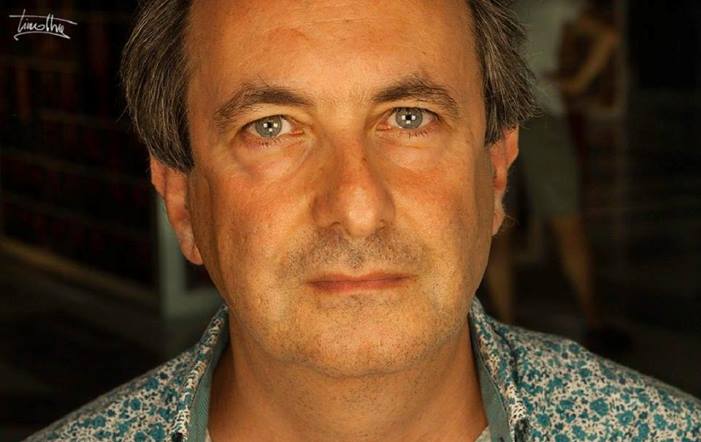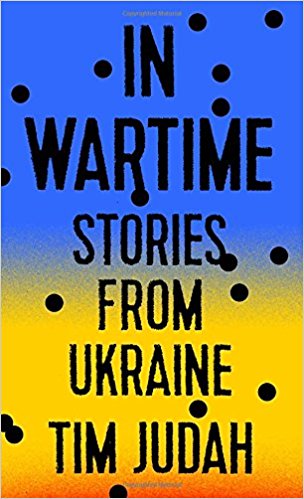Nash Holos: Judah in Wartime

“Wherever I went I found, as in few other places I have been, just how happy ordinary people were happy to talk. Then I understood that this was because no one ever asks them what they think.”
So writes Tim Judah, a reporter for The Economist, in his compelling book In Wartime: Stories from Ukraine. The Londoner Judah covered the war in Ukraine for The New York Review of Books.
Judah has a specific approach in his portrayal of the complexities of today’s Ukraine for the Western reader. He stressed that he wanted to mix people, stories, history, politics, and reportage instead of explaining why one event followed another.
 In addition to witnessing some horrifying scenes on the front lines of the war in Donbas, he traveled far and wide throughout Ukraine. He talked with people high and low, from impoverished refugees, elderly villagers, city sophisticates, and wealthy businessmen.
In addition to witnessing some horrifying scenes on the front lines of the war in Donbas, he traveled far and wide throughout Ukraine. He talked with people high and low, from impoverished refugees, elderly villagers, city sophisticates, and wealthy businessmen.
One major theme is teased out of all the talks with Ukrainians. History weighs very heavily on Ukraine, Judah writes, “because of what really happened, what people believe happened, what people are told happened, and what is forgotten.”
Furthermore, as Judah notes, what a Ukrainian believes today depends on what he or she believes about the past. And therefore he points out, “People are mobilized, believing horrendously garbled versions of history.”
These versions of history shape contemporary Ukrainian attitudes to the two searing traumas the country experienced in the twentieth century—the Holocaust and the Holodomor Famine.
Judah reminds us history refracts. The same period is remembered differently by different people. Jews, Poles, and Ukrainians have radically different memories and interpretations of events of the Second World War in the western regions of Galicia and Volhynia.
The proper commemoration of these events continues to bedevil Ukrainian society, as Judah shows in his chapters on Lviv, and specifically on the notorious Lonskoho Street Prison. The prison, now a museum, was the site of a bloody massacre of political prisoners by the Soviet secret police in the summer of 1941 just before the German occupation. And in the immediate aftermath of the occupation, it was the site of pogroms.
Judah also notes the oddly truncated historical view of the Famine in Ukrainian commemorations. He shrewdly points out that making the Holodomor a seminal event in modern Ukrainian history has to depend on who is in power.
The Holodomor has been alternately highlighted or neglected by Ukrainian authorities in terms of public remembrance. It was also of course a taboo topic during the Soviet period. Because of factors, Judah points out “the Holodomor has not entered into the DNA or soul of Ukrainian politics, or worldview, as the Holocaust and the Armenian genocide have in Israel and Armenia.”
Judah was covering and writing about Ukraine in a period of traumatic transition. And he reminds us that these traumas often arise suddenly. The long-established order can vanish overnight. Change can be swift, and lethal. Anything could happen anywhere.
In one of his chapters Judah recounts how the American Hassidic Rabbi in Lviv tells him that now there is not a single Jew left in the city whose origins are in Lviv. On Shabbat the rabbi dons his big fur shtreimel hat and walks briskly home from the synagogue. As he hauntingly reminds us, once thousands would have been walking home on a Friday night in their shtreimels.
Way across the country at the eastern end of Ukraine, Judah conjures up the charged atmosphere in Donetsk before the first blood of a new war was shed. This was just before the pro-Russian forces stormed the city. He captures the capacity of the human mind to deny reality. Judah was invited to a Seder, the Passover dinner, of the local Jewish community. As a foreign guest, he was asked to say a few words. He described the roadblocks he saw outside the city. This was all disturbingly similar to what he saw at the beginnings of the Yugoslav wars.
But his audience was not convinced. As he writes, “No one seemed to believe me. No one believed that their world was about to come crashing down. They clapped politely when I said that while the traditional saying of ‘Next year in Jerusalem!’ was fine, ‘Next year in Donetsk.’ would be good too. Few who were present would be.”
In Wartime: Stories from Ukraine by Tim Judah is published by Tim Duggan Books, an imprint of Crown Publishing, and is available from online booksellers.
This has been Ukrainian Jewish Heritage on Nash Holos Ukrainian Roots Radio. From San Francisco, I’m Peter Bejger. Until next time, shalom!
Listen to the program here.
Ukrainian Jewish Heritage is brought to you by the Ukrainian Jewish Encounter (UJE), a privately funded multinational organization whose goal is to promote mutual understanding between Ukrainians and Jews. Transcripts and audio files of this and earlier broadcasts of Ukrainian Jewish Heritage are available at the UJE website and the Nash Holos website.



















